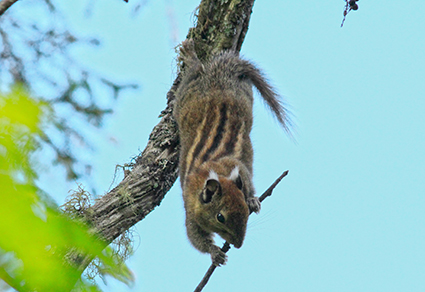Abstract
During a small mammal survey in Wanglang National Natural Reserve, Sichuan, China in August–October 2018, we collected four specimens of an Asiatic striped squirrel (genus Tamiops) that could not be assigned morphologically to any described species. Phylogenetic analyses of CYTB and nuDNA sequences strongly supported them in the genus Tamiops. The p-distances of CYTB between these individuals and other species of Tamiops ranged from 17.4 to 19.1%. Morphologically, they differed from their congeners, including T. maritimus, T. mcclellandii, T. rodolphii, and T. swinhoei by pelage, skull, and baculum characteristics. Based on the results of morphological comparisons and molecular analyses, we describe the four specimens as the new species Tamiops minshanica sp. nov.
References
Balakirev A.E. (2016) Phylogeography and taxonomy of Asian red-cheeked squirrels (Rodentia, Sciuridae, Dremomys) in Vietnam. Zootaxa (from https://www.ncbi.nlm.nih.gov/).
Chang, S. W., Oshida, T., Endo, H., Nguyen, S.T. & Lin, L. kg. (2011) Ancient hybridization and underestimated species diversity in Asian striped squirrels (genus Tamiops): inference from paternal, maternal and biparental markers. Journal of Zoology, 285, 128–138.
Tex, R., Thorington, R., Maldonado, J. E. & Leonard, J. A. (2010) Speciation dynamics in the SE Asian tropics: putting a time perspective on the phylogeny and biogeography of Sundaland tree squirrels, Sundasciurus. Molecular Phylogenetics and Evolution, 55 (2), 711–720.
Song, L., Yu, F., Su, Y., Wang, Y., Jiang, X., Mcguire, P. M., Feng, Q. & Yang, J. X. (2008) Molecular phylogeny of five species of Dremomys (Rodentia: Sciuridae), inferred from cytochrome b gene sequences. Zoologica Scripta, 37 (4), 349–354.
Mercer J. M. & Roth V. L. 2003. The effects of Cenozoic global change on squirrel phylogeny. Science, 299, 1568–1572.
Oshida, T., Dang, C. N., Nguyen, S. T., Nguyen, N. X. & Hayashi, Y. (2011) Phylogenetic relationship between Callosciurus caniceps and C. inornatus (Rodentia, Sciuridae): implications for zoogeographical isolation by the Mekong River. Italian Journal of Zoology, 78:328-335.
Oshida, T., Lin, L.K., Chang, S.W., Dang, C.N., Nguyen, S.T., Nguyen, N.X., Nguyen, D.X., Endo, H., Kimura, J. & Sasaki, M. (2017) Mitochondrial DNA evidence reveals genetic difference between Perny's long-nosed squirrels in Taiwan and Asian mainland. Mammal Study, 42, 111–116.

